
by Sheila Dunning | Jun 17, 2014
 The old cliché is “April showers bring May flowers”, but April deluges create weak plants and yellow grass. You were following the UF/IFAS recommendations and waited until April 15th to fertilize. You followed the Urban Turf Rule and applied a low-phosphate fertilizer with slow-release nitrogen. Yet, your grass is yellow and the shrubs haven’t put on any new growth. What happened? The 18” + of rainfall that we experienced at the end of April flushed nearly everything out of the soil, including any fertilizer you applied. Nitrogen and potassium are highly leachable. Phosphorus is also depleted under saturated soil conditions.
The old cliché is “April showers bring May flowers”, but April deluges create weak plants and yellow grass. You were following the UF/IFAS recommendations and waited until April 15th to fertilize. You followed the Urban Turf Rule and applied a low-phosphate fertilizer with slow-release nitrogen. Yet, your grass is yellow and the shrubs haven’t put on any new growth. What happened? The 18” + of rainfall that we experienced at the end of April flushed nearly everything out of the soil, including any fertilizer you applied. Nitrogen and potassium are highly leachable. Phosphorus is also depleted under saturated soil conditions.
If you haven’t submitted a soil test since the storm, now is the time to do so. It’s time to apply a summer fertilizer, but it needs to address all the nutrient deficiencies created from the excess rain. Soil test kits can be obtained from your County Extension office. When you get the results from the University of Florida Lab, it is important to remember the 4 Rs when applying fertilizer. It needs to be the Right Source, applied at the Right Rate, at the Right Time, and over the Right Place.
Best Management Practices (BMPs) have been developed to allow individuals to make conscientious decisions regarding fertilizer selection that will reduce the risk of water contamination. The Right Source for a BMP-compliant fertilizer is one that contains a portion of slow-release (water insoluble) nitrogen with little to no phosphorus, and a potassium level similar to the nitrogen percentage (e.g. 15-0-15, that contains 5% coated nitrogen). However, a soil test is the only way to accurately identify the specific nutrients your landscape is lacking. Many soil tests indicate a need for phosphate and currently it is illegal to apply more than 0.25 pounds per 1,000 sq. ft. without a soil test verifying the need.
Next, the fertilizer must be applied at the Right Rate. In order to do that, you must know the square footage of your property and how much you can spread using the settings on your equipment. Individuals walk at varied speeds and the product recommended rates are based on 1,000 sq.ft. areas. For information on calibrating application equipment refer to 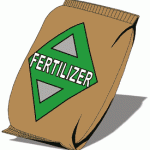 the publication, “How to Calibrate Your Fertilizer Spreader”. Using the 15-0-15 fertilizer mentioned earlier, the Right Rate for one application would be 3 pounds per 1,000 sq.ft.. That 35 pound bag is all that is needed for a nearly 12,000 sq.ft. yard (a large corner lot).
the publication, “How to Calibrate Your Fertilizer Spreader”. Using the 15-0-15 fertilizer mentioned earlier, the Right Rate for one application would be 3 pounds per 1,000 sq.ft.. That 35 pound bag is all that is needed for a nearly 12,000 sq.ft. yard (a large corner lot).
The Right Time for applying fertilizer is when the plants are actively growing and beginning to show nutrient deficiencies. Summer, when rainfall and irrigation is frequent, is often a typical application time. The Right Place is only on living plant areas. Be cautious to avoid getting fertilizer on the sidewalk, driveway and street. A deflector on your spreader is very helpful. Otherwise, be sure to sweep or blow the fertilizer back onto the grass or into the landscape beds. Avoid having fertilizer end up in any water body.
by Sheila Dunning | May 13, 2014
Last summer’s heavy rain and the stress of January’s icy weather have contributed to widespread outbreaks of Take-All Root Rot, a soil-inhabiting fungus Gaeumannomyces graminis var. graminis that causes yellow grass patches ranging in diameter from a few inches to more than 15 feet. The symptoms first appear in the spring, but disease can persist all summer and survive the winter. Over time the entire area dies as the root system rots away.
![[Click thumbnail to enlarge.]](https://edis.ifas.ufl.edu/LyraEDISServlet?command=getThumbnailImage&oid=10886581)
![[Click thumbnail to enlarge.]](https://edis.ifas.ufl.edu/LyraEDISServlet?command=getThumbnailImage&oid=9033591)
The pathogen is naturally present on warm-season turfgrass roots. High rainfall and stressed turfgrass trigger the disease. Because the roots are affected, they are not able to efficiently obtain water or nutrients from the soil, nor are they able to store the products of photosynthesis, which result in the loss of color in the leaves. By the time the leaf symptoms appear, the pathogen has been active on the roots for several weeks, probably longer; potentially years. If the turfgrass is not stressed, leaf symptoms may never be observed.
![[Click thumbnail to enlarge.]](https://edis.ifas.ufl.edu/LyraEDISServlet?command=getThumbnailImage&oid=6143337)
This disease is very difficult to control once the above-ground symptoms are observed. Measures that prevent or alleviate stress are the best methods for controlling the disease. Any stress (environmental or man-made) placed on the turf weakens it, making it more susceptible to disease. Remember, that every maintenance practice, fertilizer application, and chemical (especially herbicide), application has an impact on turfgrass health.
Cultural practices that impact the level of stress experienced by a lawn include: proper turfgrass species selection; mowing at the correct height; irrigation timing, frequency and volume; fertilizer nitrogen and potassium sources and application quantities; thatch accumulation; and soil compaction issues. The selection of turfgrass species should be based on existing soil pH, sunlight exposure, use of the area and planned maintenance level.
Mower blades must be sharp to avoid tearing of the leaves. Additionally, turfgrasses that are cut below their optimum height become stressed and more susceptible to diseases, especially root rots. When any disease occurs, raise the cutting height. Scalping the grass damages the growing point. Raising the cutting height increases the green plant tissue available for photosynthesis, resulting in more energy for turfgrass growth and subsequent recovery from disease. If an area of the lawn has an active fungus, washing or blowing off the mower following use will reduce the spread of the disease to unaffected areas.
The amount of water and the timing of its application can prevent or contribute to disease development. Most fungal pathogens that cause leaf diseases require free water (rainfall, irrigation, dew) on the leaf to initiate the infection process. Irrigating every day for a few minutes is not beneficial for the turfgrass because it does not provide enough water to the root zone, but it is beneficial for turfgrass pathogens. It is always best to irrigate when dew is already present, usually between 2 and 8 a.m., and then only apply enough water to saturate the root zone of the turfgrass.
Excessively high nitrogen fertility contributes to turfgrass diseases. The minimum amount required for the grass species should be applied. Potassium (K) is an important component in the prevention of diseases, because it prevents plant stress. Application of equal amounts of nitrogen and potassium is recommended for turfgrass health. When turfgrass roots are damaged from disease, it is beneficial to apply nutrients in a liquid solution. However, nitrate-nitrogen increases the severity of diseases, so their use should be avoided when possible. Ammonium-containing fertilizers are the preferred nitrogen sources. Heavy liming has also been linked to increases in Take-All Root Rot. Since most turfgrasses can tolerate a range of pH, maintaining soil at 5.5 to 6.0 can suppress the development of the pathogen. When the disease is active, frequent foliar applications of small amounts of nutrients is necessary to keep the turfgrass from declining.
Additional maintenance practices that need to be addressed are thatch removal and reduction of soil compaction. Excessive thatch often causes the mower to sink which can result in scalping and reducing the amount of leaf tissue capable of photosynthesizing. Thatch and compacted soil prevent proper drainage, resulting in areas remaining excessively wet, depriving root systems of oxygen.
Since recovery of Take-All – damaged turfgrass is often poor, complete renovation of the lawn may be necessary. Removal of all diseased tissue is advised. As a native, soil-inhabiting pathogen, Take-All-Root-Rot cannot be eliminated. But, suppression of the organism through physical removal followed by proper cultivation of the new sod is critical to the establishment of a new lawn. Turfgrass management practices, not chemicals, offer the best control of the disease.
It is acceptable to use fungicides on a preventative basis while rooting in the sod. Azoxystrobin, fenarimol, myclobutanil, propiconazole, pyraclostrobin, thiophate methyl, and triadimefon are all fungicides that can be utilized to prevent disease development while having to excessively irrigate newly laid sod. Ideally, the turf area should be mowed and irrigated prior to a fungicide application. Unless the product needs to be watered in, do not irrigate for at least 24 hours after a chemical treatment. Do not mow for at least 24 hours, to avoid removal of the product attached to the leaf blades.
Now that we have added another major stress with the recent heavy rain, it will be very important to continue monitoring the turf and being cautious about the cultural practices being used. Take-All Root Rot is likely to flourish. Do not encourage its development.
by Julie McConnell | May 3, 2014
The last week of April 2014 brought with it 10-22 inches of rain across the panhandle in a matter of days. Some areas had immediate flooding and standing water, while others may be in areas at risk of rising rivers and streams. As the water recedes, many people are wondering how all the water will affect their landscapes.
Only time will tell what the long term impact will be, but here are a few things to watch for and what you can do to try to moderate damage.
- Let soils dry out before driving vehicles or other equipment on grassy areas. Even if the water is not visible, if the soil is still saturated, driving lawn equipment or cars may cause ruts.
- Do not leave automatic irrigation systems running on established shrubs, trees, and lawns. If your system is set to run in the early morning hours, you may not think about it being on, check your systems and hold off on adding water until soils dry out and the plants need it.
- Watch for fungus symptoms and treat if needed. Wet plants and cool weather are ideal for some Brown Patch on lawns, be aware and monitor landscapes closely. If disease is suspected, contact your local county extension office for recommendation.
- When mowing, leave a longer leaf blade to compensate for root stress.
- Look at the base of trees and shrubs to make sure silt and sand have not buried the crown or root flare. Also look for erosion of root zone, these areas may need correction. “Salvaging Flood-Damaged Shrubs and Ornamentals.”
- Adjust fertilization as needed; if you recently applied fertilizer it has likely runoff or leached from the site. However, if you suspect fungal disease do not fertilize until disease is managed.
- Stress in turfgrass, for details read “Watch Turf for Flooding Stress”
- You may see new weeds (seeds or segments may have washed or blown into your yard)
- Tree and shrub decline or death read “We Had Plenty of Rain, Why are My Trees Dying?”
- Although this storm was not a hurricane, “Assessing Damage and Restoring Trees After a Hurricane” has helpful information for areas with wind damage
- Nutritional deficiency symptoms in palms may show up 4-5 months from now. “Nutrient Deficiencies of Landscape and Field-grown Palms in Florida.”
- Decreased availability and increased price of sod (flooded fields prevent harvest and increase inputs for disease, weed, and nutrition management)
- Scheduling changes or maintenance adjustments by landscape contractors. Turfgrass and ornamentals will likely need different maintenance applications than in years past to correct issues related to flooding and excess rain.
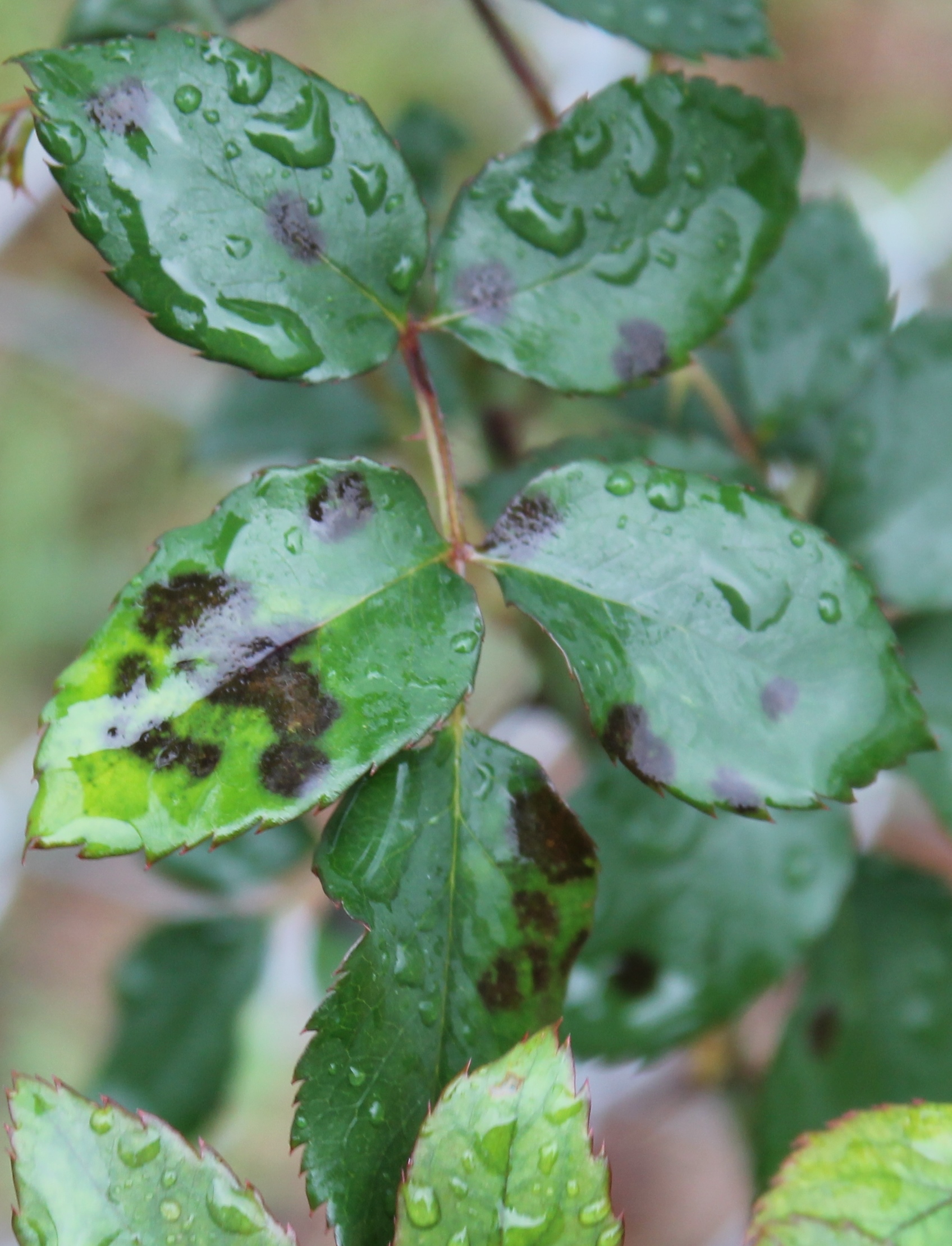
by Matthew Orwat | Mar 18, 2014
March may seem a little early to worry about fungal diseases, but recent prolonged wet weather and warmer temperatures have made the climate just right for a variety of leaf diseases in the Florida Panhandle. One in particular, Blackspot (Diplocarpon rosae), is particularly problematic for the discerning rose grower. Blackspot is just beginning to be seen this season on non-resistant rose cultivars throughout the central Florida panhandle.
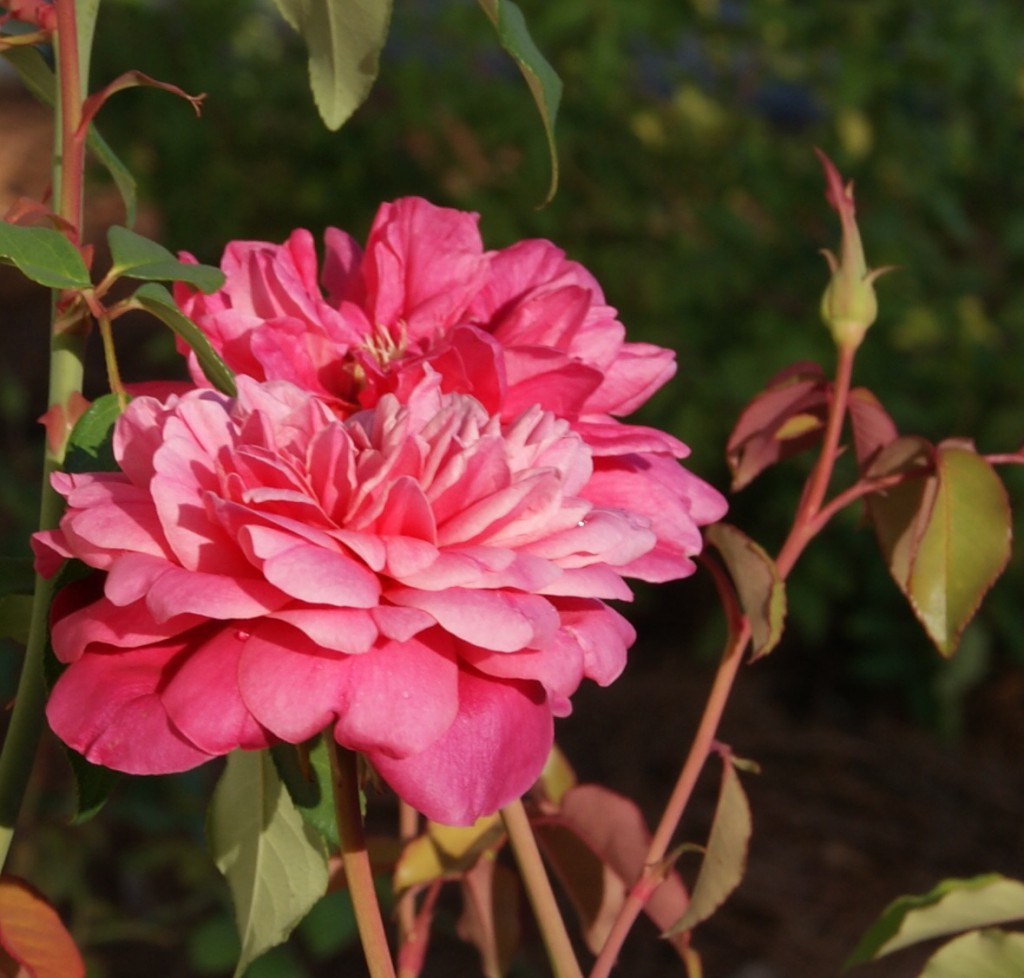
Monsieur Tillier, a rose that shows promise for blackspot resistance, is also part of the Earthkind program. Image Credit Matthew Orwat
Blackspot spores are spread from the canes or leaves of the previous season’s growth by rain or overhead irrigation. To minimize innoculum (black spot spores) remove all leaves from the previous season and any dead leaves at the base of the plant. After the annual pruning in mid to late February, it is a good idea to spray roses with sulfur or copper based fungicidal soap. This helps kill spores that have been laying dormant throughout the winter. Be careful not to spray these products when temperatures rise above 80 ° F. Doing so could burn the plants, although these products will damage tender young growth as well at temperatures below 80 ° F .
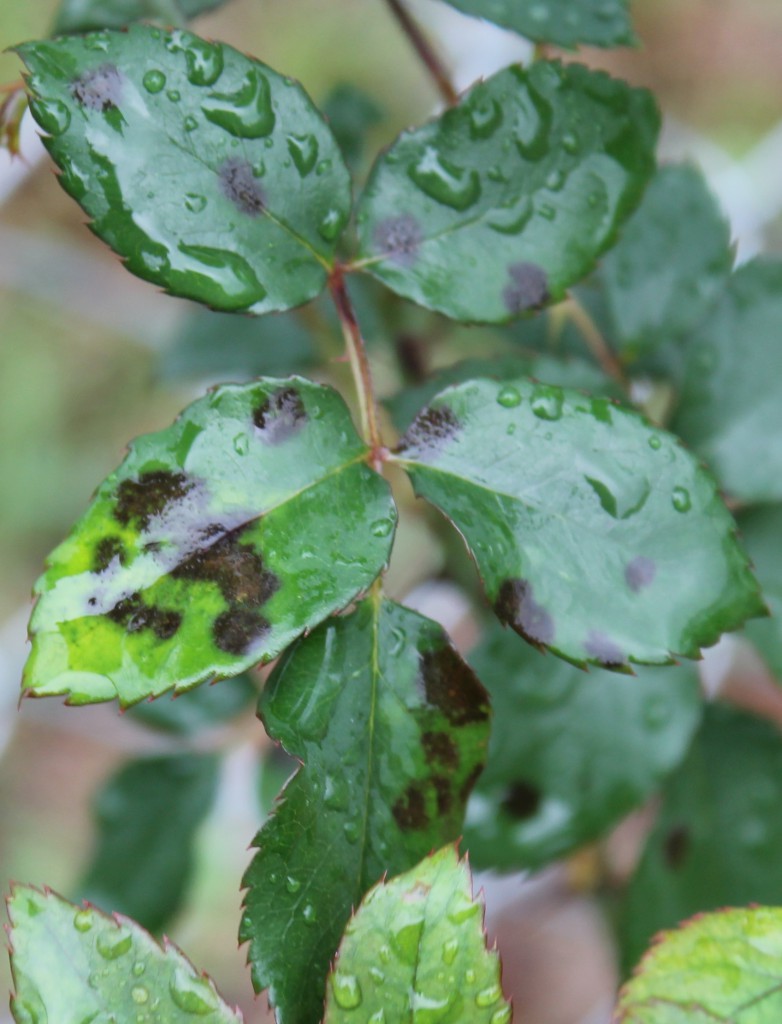
Wet, blackspot affected leaves. Image Credit Matthew Orwat
While dormant sprays often allow rose gardeners to get ahead of the disease, the best defense for the home garden is to plant resistant cultivars. There are several old and new resistant cultivars on the market. Some new resistant cultivars of note include Home Run and Knockout. Also, several older cultivars have demonstrated excellent resistance, such as Mrs. B.R. Cant and Spice. The author has been working with several older rose cultivars at the UF / IFAS Washington County Extension demonstration garden that have shown resistance during the last three years. While this demonstration garden is not a scientific study, several roses that have demonstrated some merit include Belinda’s Dream, Monsieur Tillier, Mme. Antoine Mari, Rosette Delizy and Souvenier de la Malmaison. Another resource for information on disease resistant roses is the Texas Earthkind rose program from Texas A&M University. While disease resistance is not always identical in different parts of the county, their recommended list gives the beginning rose gardener a good place to start.
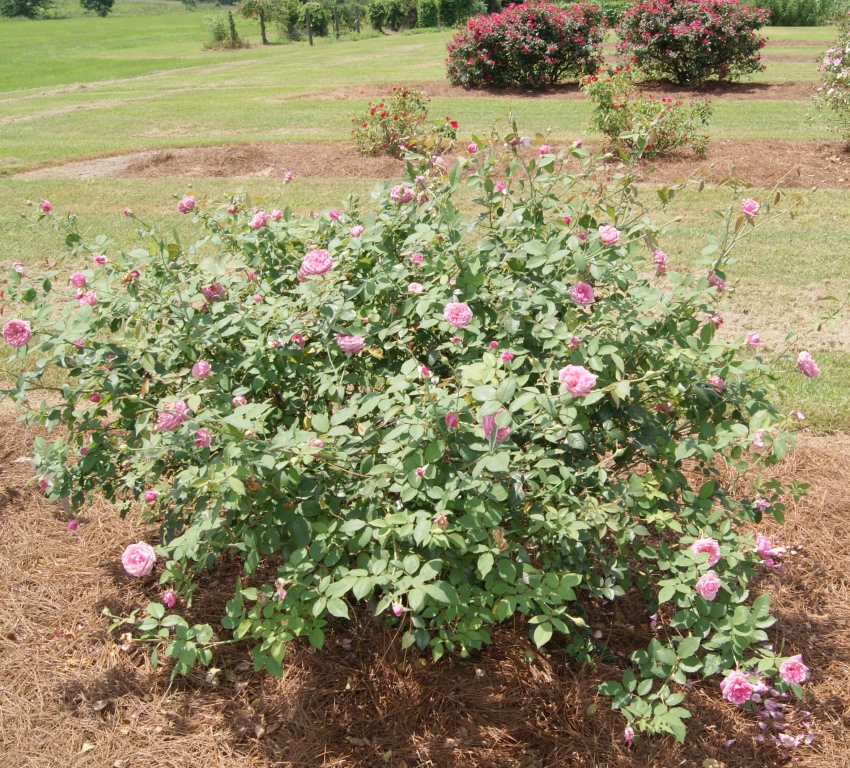
Mrs. B. R. Cant, a tea rose from 1901 has shown very good blackspot resistance at the UF IFAS rose trials in Quincy, FL. Image Credit Matthew Orwat
Several other cultural methods that will prevent spread of this disease among the rose garden include avoiding overhead irrigation, planting in well ventilated areas and proper plant spacing. These techniques attempt to make the garden environment inhospitable for blackspot proliferation.
Regardless if these management techniques are followed, if traditional large, long-stemmed, high maintenance Hybrid Tea roses are desired, most Florida rose gardeners will need to begin a spray schedule to prevent the onslaught of blackspot. Several fungicides are on the market to aid in this process, but remember that they must be used regularly (every 7-14 days) and modes of action must be rotated. This means that different types of fungicide must be rotated so that resistance to a particular fungicide by the blackspot organism does not develop. Below is a table of recommended fungicides for homeowner blackspot control. For more information, please consult the UF IFAS Extension publication P268, Blackspot of Rose.
Fungicide products marketed toward homeowners for control of black spot on roses
|
Active ingredient
|
Fungicide group
|
Trade name
|
|
Copper hydroxide
|
M1
|
Hi-Yield ® Copper |
|
Copper Sulfate
|
M1
|
Bonide® Copper Dust |
|
Copper Octanoate
|
M1
|
Bonide® Liquid Copper, Natural Guard Copper Soap, Ortho® Disease B Gon® Copper Fungicide |
|
Sulfur
|
M2
|
Bonide® Sulfur Dust, Ferti-lome® Dusting Sulfur, Green Light, Hi-Yield® Dusting Wettable Sulphur, Ortho® Bug-B-Gon® Rose & Flower Care |
|
Mancozeb
|
M3
|
Bonide® Mancozeb |
|
Captan
|
M4
|
Bonide® Captan 50WP, Hi-Yield® Captan 50W Fungicide |
|
Chlorothalonil
|
M5
|
Bonide® Fungonil, Ferti-lome® Broad Spectrum, Hi-Yield® Vegetable, Flower, Fruit and Ornamental Fungicide, Monterey, Ortho® Disease B Gon™ Garden Fungicide , Monterey Fruit Tree, Vegetable & Ornamental Fungicide |
|
Myclobutanil
|
3
|
Spectracide Immunox® Multi-Purpose Fungicide |
|
Propiconazole
|
3
|
Ferti-lome® Liquid Systemic Fungicide, Monterey Fungi-Fighter |
|
Tebuconazole
|
3
|
Bayer Advanced™ Disease Control for Roses, Flowers & Shrubs |
|
Tebuconazole + Imidacloprid
|
3 +
|
Bonide® Rose RX Systemic Drench, Feti-lome® 2-N-1 Systemic |
|
Triforine
|
3
|
Ortho® RosePride® Disease Control |
|
Calcium Polysulfide
|
NC
|
Hi-Yield® Lime Sulfur Spray |
|
Neem Oil
|
NC
|
Bonide® RX 3 in 1, Green Light® Neem Concentrate, Green Light® Rose Defense®, Monterey |
|
Acetamiprid + Triticonazole
|
NC + 3
|
Ortho® Bug B Gon® Insect & Disease Control |
|
Acephate + Resmethrin + Triforine
|
NC + NC + 3
|
Ortho® RosePride® Insect, Disease & Mite Control |
| Fungicide Group (FRAC Code): Numbers (1-37) and letters (M) are used to distinguish the fungicidal mode of action groups. All fungicides within the same group (with same number or letter) indicate same active ingredient or similar mode of action. This information must be considered in making decisions about how to manage fungicide resistance. M=Multi-site inhibitors, fungicide resistance is low; NC= not classified. Source: http://www.frac.info/ (Fungicide Resistance Action Committee, FRAC).
Always read a current product label before applying any chemicals.
|
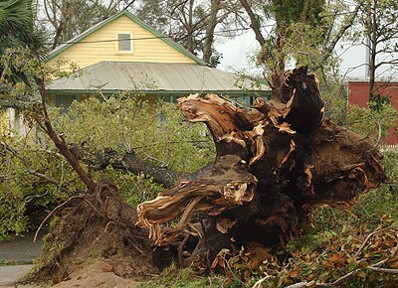
by Carrie Stevenson | Oct 7, 2013
After severe weather of any kind, homeowners must often spend a considerable amount of time dealing with impacts to their landscapes. Below are a few lessons we have learned from hurricanes and tropical storms in the past. Many thanks to fellow agent Beth Bolles for her contributions to this article.
Dealing with Toppled Trees
It may be difficult to turn an uprooted favorite tree into firewood, but this is probably the best choice. A small or young tree may be replanted successfully if done immediately. These trees will require bracing for up to two years until the root systems regrow and are able to support themselves. If the roots have been exposed for an extended period of time, don’t try and save the tree. Exposed roots should be covered with soil or moist burlap for protection from drying out. Large or older trees will typically not survive this ordeal even with the best of care. Because the root system is compromised, attempting to keep the tree may create a hazard down the road with the next storm.
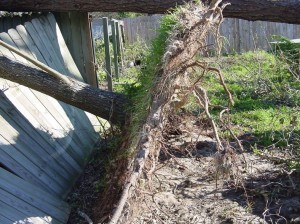
If a tree is completely uprooted, its odds of recovery are severely limited and it is best to remove the tree. Photo courtesy Beth Bolles, UF IFAS Extension
When removing fallen trees, think ahead about whether you plan to remove stumps. It’s a lot easier to pull instead of dig stumps out of the ground, so leave a four-foot stump to make your life easier. Be careful using power equipment like chain saws. It may be better to hire a professional to deal with removing large trees, especially around power lines.
Exposed Roots or Leaning Trees
Any exposed roots should be covered immediately. Cover roots with nearby soil at the same level roots were originally growing. Do not bank the soil higher because this will cut off oxygen supplies to roots in an already oxygen deprived, saturated soil.
If small trees are leaning and need straightening, they can be staked and treated like a newly planted tree. Larger trees with trunks greater than six inches in diameter can be saved but should be removed if they are a hazard to structures, power lines, or roadways. Reset the trees with stakes or guy wires for support. Trees with trunks measuring less than two inches in diameter can be supported with two or three forty-eight inch, two inch by two inch wood stakes placed one foot outside of the root ball inserted eighteen inches into the ground. Larger trees should be anchored with three or four guy wires or cables. Cover guy wires that are in contact with the trunk with rubber hoses to prevent damage.
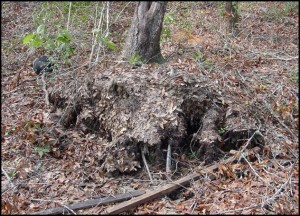
A leaning, partially uprooted tree may recover if it is righted and its roots are covered back with soil. Photo courtesty Beth Bolles, UF IFAS Extension
Replace the soil around the area and firm to assure there are no air pockets around the roots. Make sure the top root coming off the trunk is level with the existing soil. If many trees were swaying back and forth during the wind, there may be air pockets underneath the trees. If this is obvious, add soil and water to eliminate any air pockets. If root damage is obvious, do not fertilize at this time because salts in the fertilizer may damage new feeder roots.
Broken Branches
Broken branches should be removed from trees and shrubs as soon as possible to prevent tearing into trunk wood. Make clean cuts just outside of the branch collar to avoid damaging the trunk. If these are large branches, make three separate cuts to prevent tearing. Make the first cut on the underside of the branch about fifteen inches from the trunk and one-third through the branch. The second cut is made from the top, a few inches out from the first cut. This cut should remove the weight of the branch so the next one will not rip the trunk. The remaining stub can be held while the last cut is made. Make the last cut just outside the branch bark ridge and end outside the trunk collar (swollen area on lower side of branch). This is not a flush cut with the trunk and should leave a small protrusion on the trunk. Do not use wound dressing on the cut surface, as this practice is no longer recommended.
If trees lost all of their branches, it is advisable to remove the tree. The natural shape is gone and trees like pines will typically not recover. Some trees may lose the majority of their leaves, but these will flush back out so they should be okay.
Repairing Lawns
Keep a close eye on lawns for disease problems due to all the rain. Brown patch and take-all root rot would be the major concerns. Rake and remove all debris to give lawns a chance to dry out. If lawn areas are damaged, now is the time to replace with plugs or sod so they can establish before winter. Sod webworms are bad now so don’t mistake this damage for diseases. If adult moths are obvious and grass blades are closely cropped, this is due to caterpillar damage…not disease.
Watering
Most soils are saturated and irrigation systems should be in the off-mode. If there is standing water around trees or in other low areas, use a hose to siphon water to a retention pond or a better-drained area. Once soils dry out and the sun comes out, keep a close eye on plants as they may require more frequent irrigation because of root damage. Coastal areas flooded with saltwater may experience damage from extended exposure to high salinity; it is recommended to run a sprinkler system to flush out a lawn after the water retreats.
If you have questions, contact your local UF IFAS Extension Office!
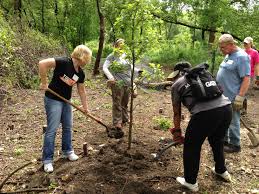
by | Sep 16, 2013
While the recently passed Labor Day is often is touted as the traditional “end of summer,” according to the calendar, fall officially will begin with the fall equinox on Sept. 22nd at 4:44 EDT. In north Florida, however, we know good and well that our summer season extends a good bit longer.
Still, even if it just feels right, there is something going on now. When you walk out in the morning, the air feels just a bit more comfortable. The days are getting shorter, and that is beginning to have an effect. Perhaps it’s just wishful thinking, but if you squint just right, you can ALMOST see the end of our long and brutally hot summer.
The word “fall” commonly conjures up images of harvest, falling leaves, the end of the growing season and the beginning of dormancy leading into winter. For gardeners in North Florida, however, the traditional fall period is not a time of winding things down in the garden or even landscape but of revival and renewed effort. It’s a time when we finally can get back into outside and enjoy ourselves as the debilitating heat of summer starts to lose its grip on the weather.
For the next couple of months we will experience a gradual shift to milder weather. There will be cool spells followed by decidedly hot, summer-like weather, but as we move into late October, cooler weather will begin to dominate the scene. Not until mid-to late November do we generally experience the nippy cold weather and changing leaves that tell us, yes, indeed, fall has finally arrived.
One thing you that you might notice that may surprise you may be an increase of vigor in your warm-season bedding plants in September. Even heat-tolerant flowers do not always look their best in August.
Since shorter days mean fewer hours of intense heat, even though the daytime highs may stay about the same, plants begin to experience less stress. This encourages a “second wind”, if you will, in the flower garden that may last well into October or early November. Given this, consider cutting back some of your summer bedding plants and flowers that have grown tall and leggy over the just passed long growing season. This should be done in by the second or third week in September at the latest – and generally involves cutting plants back about one-third to one-half their height.
While you’re at it, it might be a good idea to impose some order on those overgrown flower beds. In addition to cutting back, groom plantings to remove dead flowers and unattractive foliage.
If plants are leaning or have fallen over onto nearby neighbors, prop them up or stake them so they will stand upright. Just about every year at this time I find the remains of some unfortunate plant that was overwhelmed when larger, more vigorous, nearby plants leaned over it.
In addition, if you haven’t done so already, gently trim your everblooming rose bushes, including such popular groups as Hybrid Teas, Grandifloras, Floribundas, Miniatures, Teas, Polyanthas, Bourbons, Chinas and English roses, to name just a few. This should be a very light trimming, little more than deadheading, since the main pruning of everblooming types is done in mid February. On the other hand, keep in mind that many old-fashioned climbers, ramblers, Lady Banks roses and some bush roses that bloom heavily only in spring to early summer will bloom next year on the growth they made this summer. Those roses should not be cut back at all now.
Even though you can get back into the garden to work, it is still too early to plant hardy trees, shrubs, ground covers and vines in the landscape. Temperatures in the 80s and 90s likely will be common in September, and that is still too stressful for new plantings. Wait at least until the cooler weather of October, since the ideal planting season for hardy trees, shrubs and ground covers really is from November through February. And for those that like to plant pecan trees, these are often done in bare root when the trunk of the tree is about the size of a pencil. These MUST be done when completely dormant or you will not have a successful outcome.

While Fall is for Planting, be sure that you don’t start too early!
Keep in mind that even though they will begin to show up in area nurseries this month, it is also is too early to plant cool-season bedding plants. Even if you have an area where your summer flowers have finished and have been removed, it is still too hot to plant most cool-season bedding plants. Instead mulch the area now and wait until the reliably cooler weather of October or November before you plant your bedding plants.
Spring-flowering bulbs, such as tulips and daffodils, become available this month, but there is absolutely no hurry to plant them. Purchase them if you like while the selection is good, but wait to plant your spring flowering bulbs from mid-October through early December.
Keep in mind that insects and diseases stay active through the fall, so continue to control any pest problems with timely applications of the proper material. In addition, don’t forget, now as always, water well during dry periods, and you should have an excellent crop of flowers in October through November.
I guess if you think about it, it’s best to say that Labor Day really marks that time in north Florida when we can anticipate the soon-to-arrive milder weather and look forward to enjoying the delights of gardening over the next few months. When the fall equinox arrives later this month, don’t get carried away. For us, summer will still be lingering for a little while longer.

 The old cliché is “April showers bring May flowers”, but April deluges create weak plants and yellow grass. You were following the UF/IFAS recommendations and waited until April 15th to fertilize. You followed the Urban Turf Rule and applied a low-phosphate fertilizer with slow-release nitrogen. Yet, your grass is yellow and the shrubs haven’t put on any new growth. What happened? The 18” + of rainfall that we experienced at the end of April flushed nearly everything out of the soil, including any fertilizer you applied. Nitrogen and potassium are highly leachable. Phosphorus is also depleted under saturated soil conditions.
The old cliché is “April showers bring May flowers”, but April deluges create weak plants and yellow grass. You were following the UF/IFAS recommendations and waited until April 15th to fertilize. You followed the Urban Turf Rule and applied a low-phosphate fertilizer with slow-release nitrogen. Yet, your grass is yellow and the shrubs haven’t put on any new growth. What happened? The 18” + of rainfall that we experienced at the end of April flushed nearly everything out of the soil, including any fertilizer you applied. Nitrogen and potassium are highly leachable. Phosphorus is also depleted under saturated soil conditions. the publication, “How to Calibrate Your Fertilizer Spreader”. Using the 15-0-15 fertilizer mentioned earlier, the Right Rate for one application would be 3 pounds per 1,000 sq.ft.. That 35 pound bag is all that is needed for a nearly 12,000 sq.ft. yard (a large corner lot).
the publication, “How to Calibrate Your Fertilizer Spreader”. Using the 15-0-15 fertilizer mentioned earlier, the Right Rate for one application would be 3 pounds per 1,000 sq.ft.. That 35 pound bag is all that is needed for a nearly 12,000 sq.ft. yard (a large corner lot).







